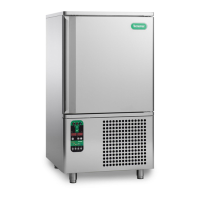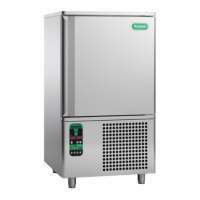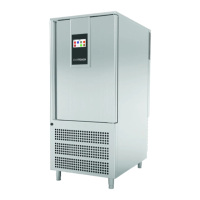Do you have a question about the Tecnomac BK+ 5.16 A and is the answer not in the manual?
This manual provides information for installation, operation, and maintenance of the machine.
Machine installation must be performed by a specialized technician following manual instructions and regulations.
Guidelines for loading/unloading machines using lift trucks or forklifts, considering machine dimensions and weight.
Instructions for removing packaging materials and checking the machine for damage.
Key safety rules for operating the machine, emphasizing user responsibility and compliance.
Check data plate for power supply compatibility (V, kW, Hz, phases) before installation.
Information required for reporting machine malfunctions or claims, whether assembled or disassembled.
Ensure the machine is installed level and compliant with safety and local regulations.
Maximum operating ambient temperature is 32°C; ensure sufficient air circulation for correct operation.
Proper electrical connection requires a dedicated thermal-magnetic circuit breaker and earthing.
Guidelines for connecting refrigeration components, including power lines for remote assemblies.
Fit a condensate/wash water drainage hose with a minimum diameter of 1" and provide a waste pipe.
Pre-startup checks for installers, including leak tests, connections, and system pressure.
Overview of safety features like door microswitch, fuses, compressor heat relay, and pressure switches.
Information on the proper disposal of the product as WEEE to prevent environmental harm.
Emergency shutdown can be performed by switching off power at the main panel or removing the plug.
General advice for optimal operation, including pre-cooling and proper food arrangement.
Pre-cool the cell before first use or after disuse until the set operating temperature is reached.
Load food items separately and ensure adequate space for air circulation between trays.
Instructions for powering up the machine and understanding its STAND-BY or OFF conditions.
Procedure for setting the internal clock, including year, month, day, hour, and minutes.
Overview of various operational modes including blast chilling, freezing, and drying cycles.
Selecting and starting a timed positive blast chilling cycle, with automatic transition to storage.
Selecting a temperature-controlled positive blast chilling cycle with probe insertion.
Selecting a timed positive hard blast chilling cycle, with automatic transition to preservation phase.
Selecting a temperature-controlled positive hard blast chilling cycle with specific core probe temperature.
Starting a timed blast freezing cycle, with automatic transition to storage mode upon completion.
Selecting a temperature-controlled blast freezing cycle, ensuring the core probe reaches the set temperature.
Starting a positive blast chilling cycle for an indefinite amount of time, useful for rapid chilling.
Using the blast chiller for ice cream hardening or freezing with indefinite timed cycles.
Instructions for selecting and using the drying cycle with forced ventilation.
Viewing operation values such as set time, final temperature, and probe temperature during cycles.
Activating a time-controlled sanitizing cycle after processing is completed.
Accessing and modifying machine parameters by entering a specific code when the machine is off.
A comprehensive list of available parameters for temperature units, set points, and cycle times.
Manual defrosting is initiated by pressing the Defrost button for 3 seconds while in standby.
Registering cycle data to a .txt file via USB, including date, time, temperature, and cycle type.
Soft blast chilling for delicate products, cooling from +70°C to 3°C within 90 minutes.
Hard blast chilling for dense products, cooling from +70°C to +3°C within 90 minutes.
Rapid freezing from +70°C to -18°C within 4 hours using chamber air at -40°C.
Indicates cell sensor failure due to readings outside the operating range for over 30 seconds.
Indicates evaporator sensor failure due to readings outside the operating range for over 30 seconds.
Indicates product probe failure due to readings outside the operating range for over 30 seconds.
An alarm triggered when the door is opened during standby or defrost.
Indicates high pressure in the refrigerant circuit, blocking the cycle and returning to standby.
Alarm indicating the temperature probe was not inserted during a controlled blast chilling cycle.
Alarm indicating a power interruption, requiring the machine to restart or enter standby mode.
Alarm when the chiller fails to reach the set temperature within the expected time.
Cell sensor detects temperature above set parameters during storage, triggering an alarm.
Indicates an error in the internal clock, requiring the date and time to be reset.
Communication error between the user interface and the control module.
Reiteration of safety standards for performing maintenance and cleaning operations safely.
Keep the air condenser clean for efficient operation, removing dust and fluff with a non-metallic brush.
Regular cleaning of the cell interior using water and non-abrasive neutral detergents for hygiene.
Cleaning the appliance body with a cloth dampened with a product for stainless steel, without bleach.
Ensure evaporator water drains correctly into the collection basin, avoiding drain pipe obstructions.


